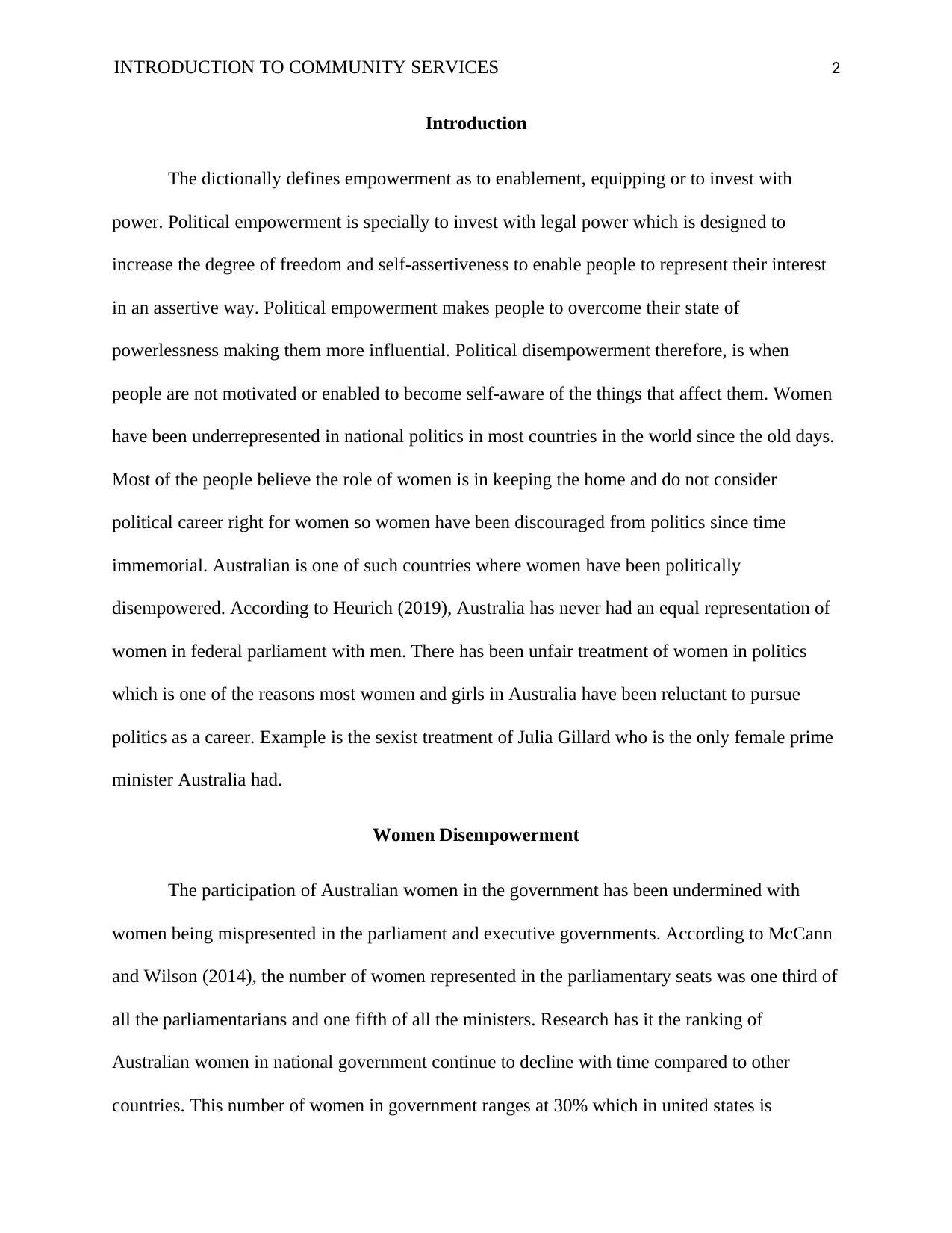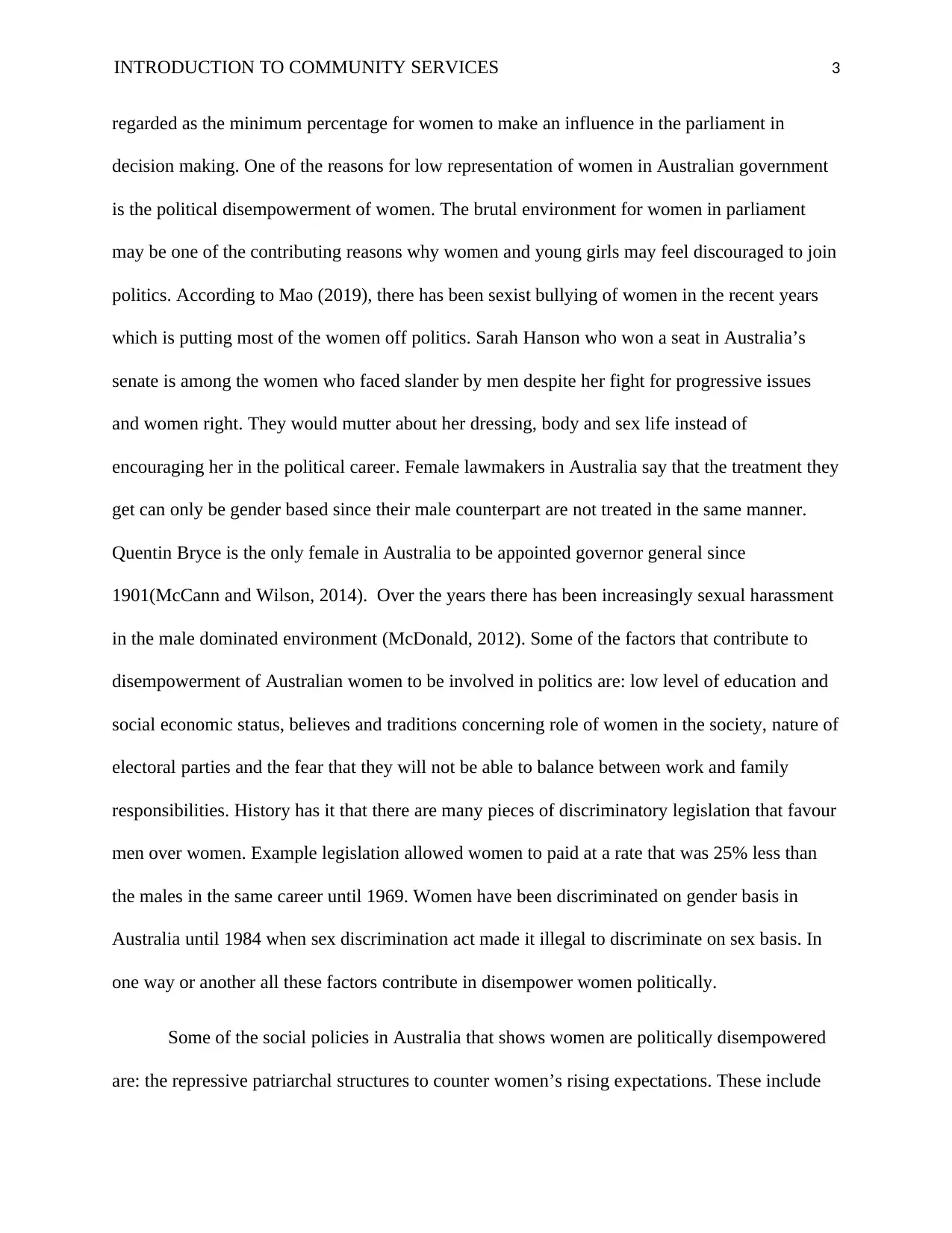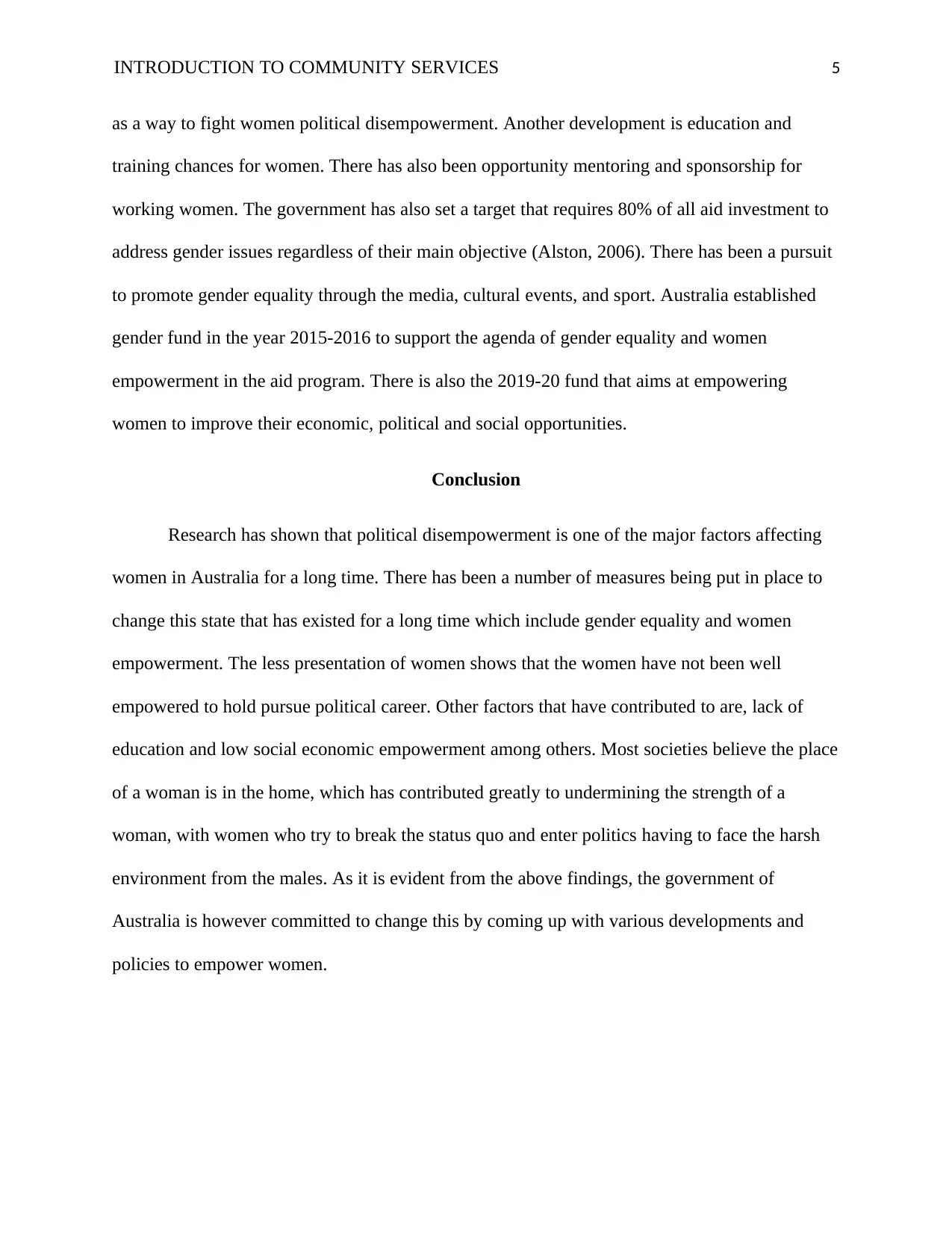Analysis of Women's Political Disempowerment in Australia: Policies
VerifiedAdded on 2022/10/01
|6
|1534
|440
Essay
AI Summary
This essay provides an introduction to the political disempowerment of women in Australia, examining the factors contributing to their underrepresentation in government and the challenges they face. It discusses historical and ongoing issues, including sexist treatment, discriminatory legislation, and societal beliefs that limit women's political involvement. The essay highlights relevant social policies and government initiatives aimed at empowering women, such as gender equality policies, women empowerment programs, and quotas. It also explores recent developments like the appointment of an ambassador for women and girls, educational opportunities, and equal pay initiatives. The conclusion emphasizes the government's commitment to addressing this long-standing issue through various policies and programs designed to promote gender equality and women's empowerment.

Running head: INTRODUCTION TO COMMUNITY SERVICES
Introduction to Community Services
Student’s Name
Institution Affiliation
Introduction to Community Services
Student’s Name
Institution Affiliation
Paraphrase This Document
Need a fresh take? Get an instant paraphrase of this document with our AI Paraphraser

INTRODUCTION TO COMMUNITY SERVICES 2
Introduction
The dictionally defines empowerment as to enablement, equipping or to invest with
power. Political empowerment is specially to invest with legal power which is designed to
increase the degree of freedom and self-assertiveness to enable people to represent their interest
in an assertive way. Political empowerment makes people to overcome their state of
powerlessness making them more influential. Political disempowerment therefore, is when
people are not motivated or enabled to become self-aware of the things that affect them. Women
have been underrepresented in national politics in most countries in the world since the old days.
Most of the people believe the role of women is in keeping the home and do not consider
political career right for women so women have been discouraged from politics since time
immemorial. Australian is one of such countries where women have been politically
disempowered. According to Heurich (2019), Australia has never had an equal representation of
women in federal parliament with men. There has been unfair treatment of women in politics
which is one of the reasons most women and girls in Australia have been reluctant to pursue
politics as a career. Example is the sexist treatment of Julia Gillard who is the only female prime
minister Australia had.
Women Disempowerment
The participation of Australian women in the government has been undermined with
women being mispresented in the parliament and executive governments. According to McCann
and Wilson (2014), the number of women represented in the parliamentary seats was one third of
all the parliamentarians and one fifth of all the ministers. Research has it the ranking of
Australian women in national government continue to decline with time compared to other
countries. This number of women in government ranges at 30% which in united states is
Introduction
The dictionally defines empowerment as to enablement, equipping or to invest with
power. Political empowerment is specially to invest with legal power which is designed to
increase the degree of freedom and self-assertiveness to enable people to represent their interest
in an assertive way. Political empowerment makes people to overcome their state of
powerlessness making them more influential. Political disempowerment therefore, is when
people are not motivated or enabled to become self-aware of the things that affect them. Women
have been underrepresented in national politics in most countries in the world since the old days.
Most of the people believe the role of women is in keeping the home and do not consider
political career right for women so women have been discouraged from politics since time
immemorial. Australian is one of such countries where women have been politically
disempowered. According to Heurich (2019), Australia has never had an equal representation of
women in federal parliament with men. There has been unfair treatment of women in politics
which is one of the reasons most women and girls in Australia have been reluctant to pursue
politics as a career. Example is the sexist treatment of Julia Gillard who is the only female prime
minister Australia had.
Women Disempowerment
The participation of Australian women in the government has been undermined with
women being mispresented in the parliament and executive governments. According to McCann
and Wilson (2014), the number of women represented in the parliamentary seats was one third of
all the parliamentarians and one fifth of all the ministers. Research has it the ranking of
Australian women in national government continue to decline with time compared to other
countries. This number of women in government ranges at 30% which in united states is

INTRODUCTION TO COMMUNITY SERVICES 3
regarded as the minimum percentage for women to make an influence in the parliament in
decision making. One of the reasons for low representation of women in Australian government
is the political disempowerment of women. The brutal environment for women in parliament
may be one of the contributing reasons why women and young girls may feel discouraged to join
politics. According to Mao (2019), there has been sexist bullying of women in the recent years
which is putting most of the women off politics. Sarah Hanson who won a seat in Australia’s
senate is among the women who faced slander by men despite her fight for progressive issues
and women right. They would mutter about her dressing, body and sex life instead of
encouraging her in the political career. Female lawmakers in Australia say that the treatment they
get can only be gender based since their male counterpart are not treated in the same manner.
Quentin Bryce is the only female in Australia to be appointed governor general since
1901(McCann and Wilson, 2014). Over the years there has been increasingly sexual harassment
in the male dominated environment (McDonald, 2012). Some of the factors that contribute to
disempowerment of Australian women to be involved in politics are: low level of education and
social economic status, believes and traditions concerning role of women in the society, nature of
electoral parties and the fear that they will not be able to balance between work and family
responsibilities. History has it that there are many pieces of discriminatory legislation that favour
men over women. Example legislation allowed women to paid at a rate that was 25% less than
the males in the same career until 1969. Women have been discriminated on gender basis in
Australia until 1984 when sex discrimination act made it illegal to discriminate on sex basis. In
one way or another all these factors contribute in disempower women politically.
Some of the social policies in Australia that shows women are politically disempowered
are: the repressive patriarchal structures to counter women’s rising expectations. These include
regarded as the minimum percentage for women to make an influence in the parliament in
decision making. One of the reasons for low representation of women in Australian government
is the political disempowerment of women. The brutal environment for women in parliament
may be one of the contributing reasons why women and young girls may feel discouraged to join
politics. According to Mao (2019), there has been sexist bullying of women in the recent years
which is putting most of the women off politics. Sarah Hanson who won a seat in Australia’s
senate is among the women who faced slander by men despite her fight for progressive issues
and women right. They would mutter about her dressing, body and sex life instead of
encouraging her in the political career. Female lawmakers in Australia say that the treatment they
get can only be gender based since their male counterpart are not treated in the same manner.
Quentin Bryce is the only female in Australia to be appointed governor general since
1901(McCann and Wilson, 2014). Over the years there has been increasingly sexual harassment
in the male dominated environment (McDonald, 2012). Some of the factors that contribute to
disempowerment of Australian women to be involved in politics are: low level of education and
social economic status, believes and traditions concerning role of women in the society, nature of
electoral parties and the fear that they will not be able to balance between work and family
responsibilities. History has it that there are many pieces of discriminatory legislation that favour
men over women. Example legislation allowed women to paid at a rate that was 25% less than
the males in the same career until 1969. Women have been discriminated on gender basis in
Australia until 1984 when sex discrimination act made it illegal to discriminate on sex basis. In
one way or another all these factors contribute in disempower women politically.
Some of the social policies in Australia that shows women are politically disempowered
are: the repressive patriarchal structures to counter women’s rising expectations. These include
⊘ This is a preview!⊘
Do you want full access?
Subscribe today to unlock all pages.

Trusted by 1+ million students worldwide

INTRODUCTION TO COMMUNITY SERVICES 4
cultural and social dislocation where cultural prime concern of dominant group seeks to suppress
the demands and needs of a particular minority group. Women coming up with cultural models
like feminist culture and politics for women. Social movements that highlight symbolic
challenges among women like struggles of affirmative action, right to sexuality, reproductive
rights and equal pay among others (Hatton, 2016). The decision by the Australia’s government to
enforce gender equality policies aiming at empowering women shows that women have been
disempowered making them unfit for political career. Gender equality will enhance women voice
in decision making and in matters of leadership, empower women economically and end
violence against women and girls among others. Other social policies include women
empowerment programs by the Australia’s government. Such programs included policies to
protect women and girls against violence, raise the number of women in governments and
indigenous program started to respond to particular needs of indigenous women. There has been
also the policy about women quotas in government which allows a good presentation of women
in the government (Dahlerup, 2013).
To empower women and counter the disempowerment that women have faced for years
new developments have been put into place. Example national Australia bank has chosen to
become women employer of choice. In the year 2017, Australian government appointed an
ambassador for women and girls with the role to ensure that the main focus of Australia’s
diplomat, development and defense concerns is to empower women and girls (Hattton, 2016).
This move shows the commitment by the government to give women a stronger voice in the
society while promoting gender equality. Other developments are measures to ensure females are
beneficiaries of community programs as well as ensuring the programs positively affects women.
Ensuring equal pay for same work is another recent development by the Australian government
cultural and social dislocation where cultural prime concern of dominant group seeks to suppress
the demands and needs of a particular minority group. Women coming up with cultural models
like feminist culture and politics for women. Social movements that highlight symbolic
challenges among women like struggles of affirmative action, right to sexuality, reproductive
rights and equal pay among others (Hatton, 2016). The decision by the Australia’s government to
enforce gender equality policies aiming at empowering women shows that women have been
disempowered making them unfit for political career. Gender equality will enhance women voice
in decision making and in matters of leadership, empower women economically and end
violence against women and girls among others. Other social policies include women
empowerment programs by the Australia’s government. Such programs included policies to
protect women and girls against violence, raise the number of women in governments and
indigenous program started to respond to particular needs of indigenous women. There has been
also the policy about women quotas in government which allows a good presentation of women
in the government (Dahlerup, 2013).
To empower women and counter the disempowerment that women have faced for years
new developments have been put into place. Example national Australia bank has chosen to
become women employer of choice. In the year 2017, Australian government appointed an
ambassador for women and girls with the role to ensure that the main focus of Australia’s
diplomat, development and defense concerns is to empower women and girls (Hattton, 2016).
This move shows the commitment by the government to give women a stronger voice in the
society while promoting gender equality. Other developments are measures to ensure females are
beneficiaries of community programs as well as ensuring the programs positively affects women.
Ensuring equal pay for same work is another recent development by the Australian government
Paraphrase This Document
Need a fresh take? Get an instant paraphrase of this document with our AI Paraphraser

INTRODUCTION TO COMMUNITY SERVICES 5
as a way to fight women political disempowerment. Another development is education and
training chances for women. There has also been opportunity mentoring and sponsorship for
working women. The government has also set a target that requires 80% of all aid investment to
address gender issues regardless of their main objective (Alston, 2006). There has been a pursuit
to promote gender equality through the media, cultural events, and sport. Australia established
gender fund in the year 2015-2016 to support the agenda of gender equality and women
empowerment in the aid program. There is also the 2019-20 fund that aims at empowering
women to improve their economic, political and social opportunities.
Conclusion
Research has shown that political disempowerment is one of the major factors affecting
women in Australia for a long time. There has been a number of measures being put in place to
change this state that has existed for a long time which include gender equality and women
empowerment. The less presentation of women shows that the women have not been well
empowered to hold pursue political career. Other factors that have contributed to are, lack of
education and low social economic empowerment among others. Most societies believe the place
of a woman is in the home, which has contributed greatly to undermining the strength of a
woman, with women who try to break the status quo and enter politics having to face the harsh
environment from the males. As it is evident from the above findings, the government of
Australia is however committed to change this by coming up with various developments and
policies to empower women.
as a way to fight women political disempowerment. Another development is education and
training chances for women. There has also been opportunity mentoring and sponsorship for
working women. The government has also set a target that requires 80% of all aid investment to
address gender issues regardless of their main objective (Alston, 2006). There has been a pursuit
to promote gender equality through the media, cultural events, and sport. Australia established
gender fund in the year 2015-2016 to support the agenda of gender equality and women
empowerment in the aid program. There is also the 2019-20 fund that aims at empowering
women to improve their economic, political and social opportunities.
Conclusion
Research has shown that political disempowerment is one of the major factors affecting
women in Australia for a long time. There has been a number of measures being put in place to
change this state that has existed for a long time which include gender equality and women
empowerment. The less presentation of women shows that the women have not been well
empowered to hold pursue political career. Other factors that have contributed to are, lack of
education and low social economic empowerment among others. Most societies believe the place
of a woman is in the home, which has contributed greatly to undermining the strength of a
woman, with women who try to break the status quo and enter politics having to face the harsh
environment from the males. As it is evident from the above findings, the government of
Australia is however committed to change this by coming up with various developments and
policies to empower women.

INTRODUCTION TO COMMUNITY SERVICES 6
References
Alston, M. (2006). Gender mainstreaming in practice: A view from
rural Australia. NWSA Journal, 123-147.
Dahlerup, D. (2013). Women, quotas and politics. Routledge.
Hattton, D. (2016). Empowering women – is Australia leading the pack or trailing behind?
Retrieved 4 October 2019, from https://www.globalcitizen.org/en/content/empowering-
women-is-australia-leading-the-pack-or/
Heurick, A. (2019). Women in Australian Politics: Maintaining the Rage against the Political
Machine, 22(1). Retrieved from
http://journal.media-culture.org.au/index.php/mcjournal/article/view/1498
Mao, F. (2019). 2019 election: Why politics is toxic for Australia’s women. Retrieved 4 October
2019, from https://www.bbc.com/news/world-australia-48197145
McCann, J., & Wilson, J. (2014). Representation of women in Australian parliaments
2014. Parliament of Australia. Retrieved from
https://www.aph.gov.au/About_Parliament/Parliamentary_Departments/
Parliamentary_Library/pubs/rp/rp1415/WomanAustParl
McDonald, P. (2012). Workplace sexual harassment 30 years on: A review of the
literature. International Journal of Management Reviews, 14(1), 1-17.
References
Alston, M. (2006). Gender mainstreaming in practice: A view from
rural Australia. NWSA Journal, 123-147.
Dahlerup, D. (2013). Women, quotas and politics. Routledge.
Hattton, D. (2016). Empowering women – is Australia leading the pack or trailing behind?
Retrieved 4 October 2019, from https://www.globalcitizen.org/en/content/empowering-
women-is-australia-leading-the-pack-or/
Heurick, A. (2019). Women in Australian Politics: Maintaining the Rage against the Political
Machine, 22(1). Retrieved from
http://journal.media-culture.org.au/index.php/mcjournal/article/view/1498
Mao, F. (2019). 2019 election: Why politics is toxic for Australia’s women. Retrieved 4 October
2019, from https://www.bbc.com/news/world-australia-48197145
McCann, J., & Wilson, J. (2014). Representation of women in Australian parliaments
2014. Parliament of Australia. Retrieved from
https://www.aph.gov.au/About_Parliament/Parliamentary_Departments/
Parliamentary_Library/pubs/rp/rp1415/WomanAustParl
McDonald, P. (2012). Workplace sexual harassment 30 years on: A review of the
literature. International Journal of Management Reviews, 14(1), 1-17.
⊘ This is a preview!⊘
Do you want full access?
Subscribe today to unlock all pages.

Trusted by 1+ million students worldwide
1 out of 6
Your All-in-One AI-Powered Toolkit for Academic Success.
+13062052269
info@desklib.com
Available 24*7 on WhatsApp / Email
![[object Object]](/_next/static/media/star-bottom.7253800d.svg)
Unlock your academic potential
Copyright © 2020–2025 A2Z Services. All Rights Reserved. Developed and managed by ZUCOL.


